How to determine if you qualify for TPN
Understanding TPN and Its Medical Necessity
Total Parenteral Nutrition (TPN) is a specialized form of nutritional support delivered directly into the bloodstream via intravenous infusion. It is typically reserved for patients who cannot meet their nutritional needs through traditional oral or enteral feeding methods due to various gastrointestinal conditions. Determining if you qualify for TPN involves a comprehensive evaluation by healthcare professionals, including assessments of your medical condition, nutritional status, and the functional state of your digestive system. This article explores the key criteria and medical considerations involved in assessing TPN eligibility.
Medical Indications and Conditions Justifying TPN
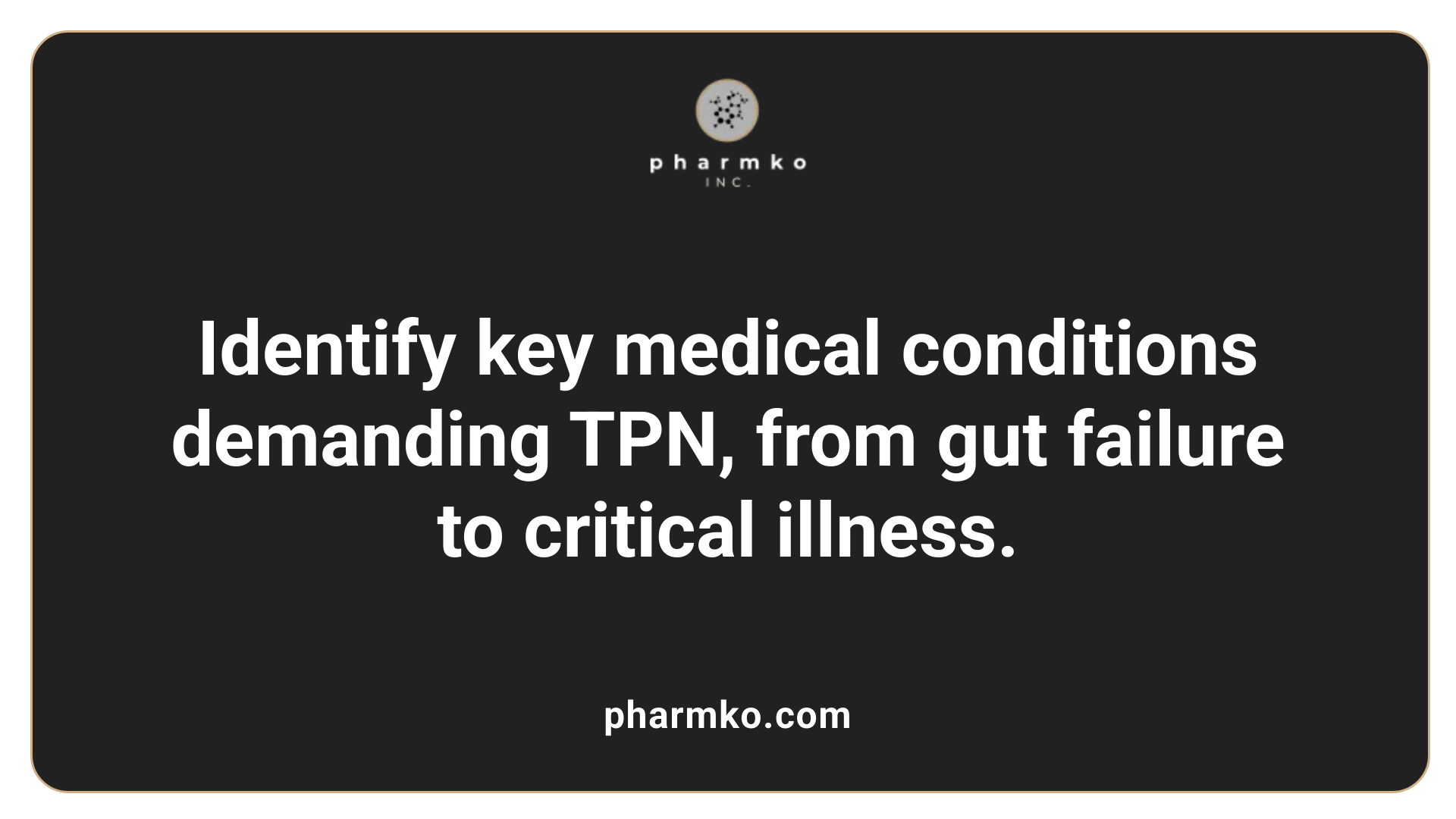
What gastrointestinal disorders require TPN?
Total Parenteral Nutrition (TPN) is often necessary when the digestive system cannot adequately absorb nutrients due to conditions like Crohn's disease, ulcerative colitis, or severe intestinal inflammation from radiation therapy. It becomes essential in cases where the gut’s ability to process and absorb essential nutrients is compromised, leading to malnutrition.
Surgical or radiation-related gut dysfunction
Patients who have experienced significant surgical removal of intestinal segments, such as in short bowel syndrome, or those with damage from radiation therapy may not absorb nutrients effectively. TPN bypasses the damaged gastrointestinal tract, delivering vital nutrients directly into the bloodstream.
Malabsorption and bowel obstruction
In cases of severe malabsorption from diseases like Crohn's or bowel obstructions that prevent food passage, TPN provides a critical nutritional alternative. It ensures sustained nutrient supply during recovery or as a long-term solution.
Critical illness and nutritional support
Critically ill patients, such as those with severe trauma, cancer, or infections, may be unable to tolerate enteral feeding. TPN supports healing and recovery by providing the necessary calories and nutrients that their bodies require to fight infection and repair tissues.
| Condition Type | Specific Conditions | Additional Details |
|---|---|---|
| Gastrointestinal Disorders | Crohn's disease, ulcerative colitis, radiation enteritis | Conditions impairing nutrient absorption or causing bowel damage |
| Surgical or Damage Conditions | Short bowel syndrome, bowel resection, abdominal trauma | Results in limited intestinal function or organ removal |
| Obstruction and Malabsorption | Bowel obstruction, fistulas, dysmotility | Blockages or dysfunction impeding normal digestion |
| Critical Illness | Severe burns, trauma, cancer, sepsis | Increased energy needs, intolerance to oral feeding |
Duration and Outcomes for Patients on TPN
The length and outlook of TPN therapy differ per patient. For many first-time users, roughly 58% survive about 1.5 years after beginning TPN. Patients with incurable cancer typically have a median survival of around 5 months, although some live longer than a year.
Long-term survival, especially in cases of intestinal failure, can range from 65% to 80% over three years when carefully managed. Overall, TPN can extend life and enhance quality of life for patients who would otherwise face severe malnutrition or organ failure. Survival prospects depend largely on age, overall health, and the underlying condition, with increased risks of complications and mortality in some cases.
Assessing Medical and Nutritional Criteria
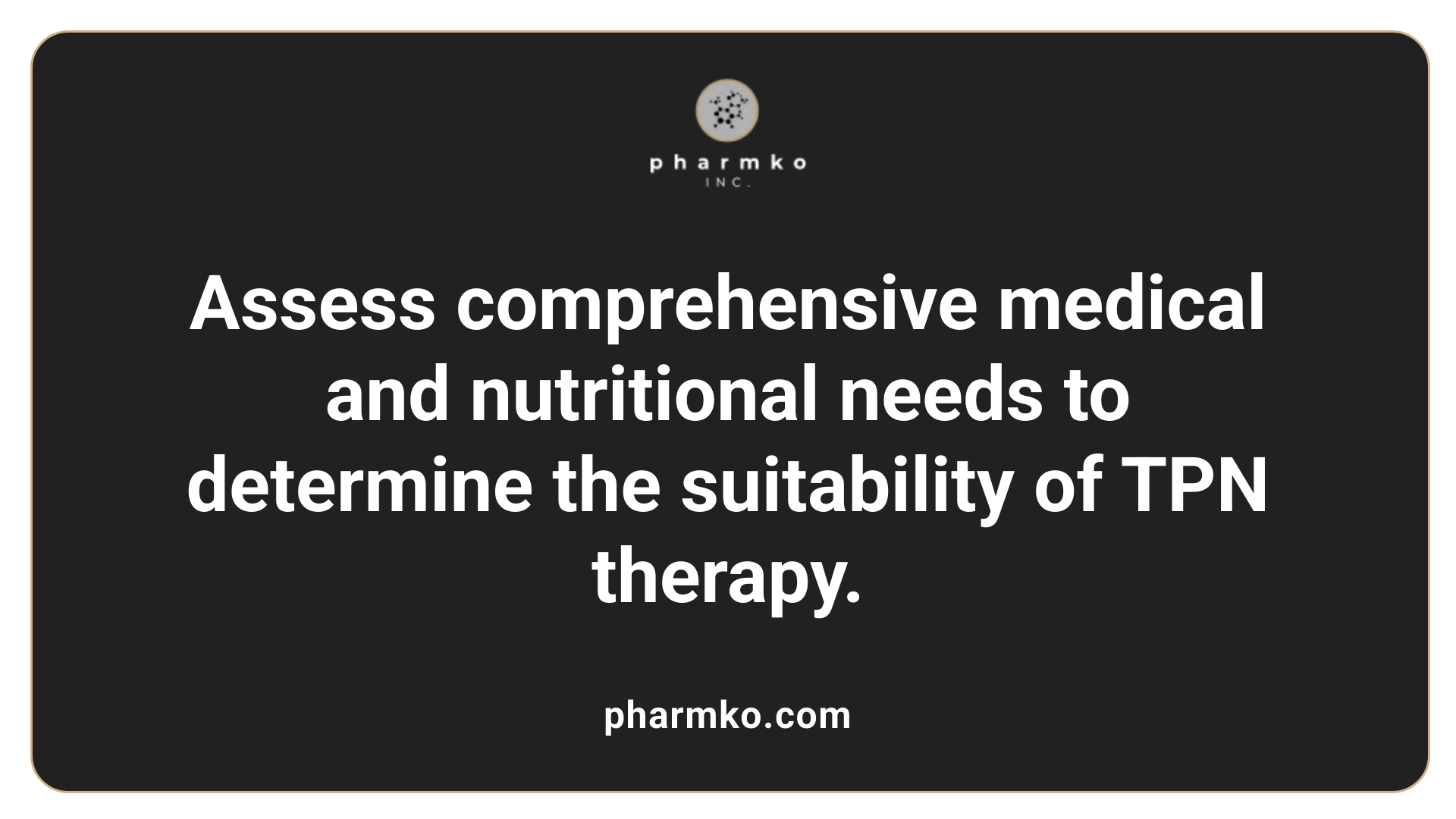
What are the requirements and considerations for TPN nutrition therapy?
Total Parenteral Nutrition (TPN) is a specialized treatment used for patients who cannot obtain adequate nutrition through the usual oral or enteral routes. The primary requirement for TPN therapy is a thorough assessment of the patient’s nutritional status and underlying health conditions. This includes evaluating whether the patient has gastrointestinal issues such as bowel obstructions, severe malabsorption, or a need for complete bowel rest.
A significant consideration is the choice of vascular access. Depending on the duration and osmolarity of the solution, a central venous catheter (such as a tunneled catheter, port, or PICC line) is typically used for long-term therapy. For shorter durations, peripheral veins may be sufficient. The nutrient mixture itself is carefully customized, containing dextrose (for energy), amino acids (for tissue repair and muscle maintenance), lipids (for additional calories and essential fatty acids), as well as vitamins, minerals, and electrolytes tailored to the individual’s needs.
Monitoring plays a crucial role in safety and effectiveness. Regular laboratory tests assess electrolyte, vitamin, and mineral levels, while clinical observation checks for signs of infection, metabolic disturbances, or organ dysfunction. Blood tests such as complete blood count, liver function tests, blood glucose, and electrolyte panels help guide therapy adjustments.
Risks associated with TPN include bloodstream infections, metabolic imbalances, liver toxicity, and potential organ damage. Therefore, the treating team—comprising clinicians, pharmacists, dietitians, and nursing staff—must work collaboratively to develop and continually update the nutrition plan.
Overall, the decision to initiate TPN involves balancing the nutritional needs against potential complications, with vigilant monitoring and adjustment ensuring safe and effective therapy.
Types of TPN Solutions and How to Choose
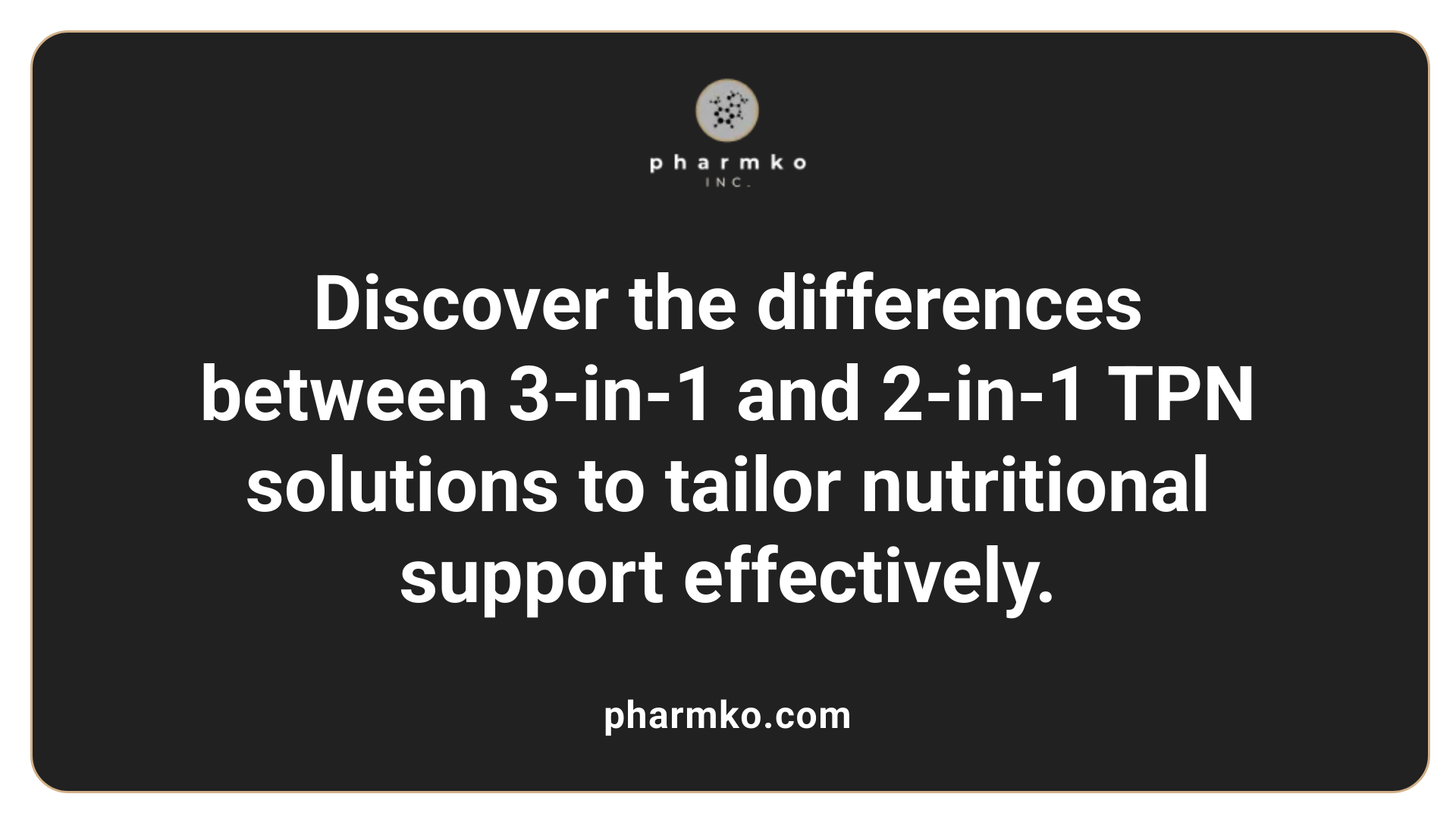
What are the different types of TPN solutions and how do you choose among them?
Total parenteral nutrition (TPN) solutions can be categorized mainly into two types: the 3-in-1 mixture and the 2-in-1 solution.
The 3-in-1 mixture, also called total nutrition admixture, combines all essential nutrients — dextrose (carbohydrates), amino acids (proteins), and lipid emulsions (fats) — into a single bag. This unified solution is typically infused through a central line and is popular because of its convenience, reducing the number of infusions needed.
On the other hand, the 2-in-1 solution separates lipid emulsions from amino acids and dextrose. Lipids are administered separately from the carbohydrate and protein mixture, allowing for adjustments in lipid intake based on patient needs. This method requires two infusion lines but offers flexibility, especially when managing lipid intolerance or specific metabolic conditions.
Choosing the right solution depends on various factors such as the patient’s metabolic status, tolerance to fats, and risk of incompatibility. Often, the 3-in-1 is preferred for its simplicity and reduced infusion burden. The decision also involves institutional protocols and the healthcare team's clinical judgment. Ultimately, personalized care, considering the patient’s condition and compatibility of nutrients, guides the selection process.
For more detailed information, searching for "types of TPN solutions" can provide additional insights into their composition, advantages, and limitations, helping both clinicians and caregivers make informed decisions.
Calculating and Administering TPN
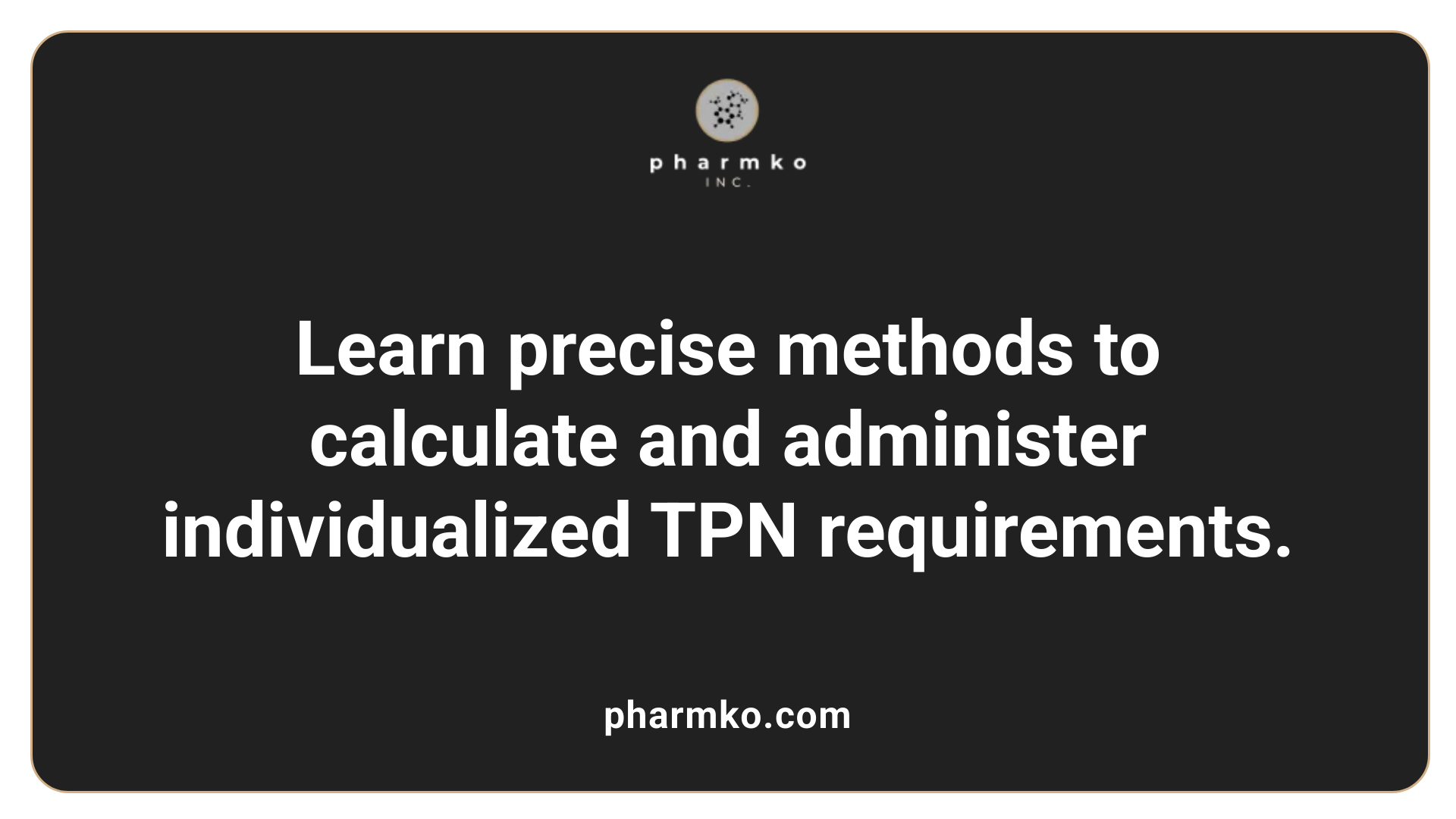
How do clinicians calculate individual TPN requirements?
Clinicians determine the precise nutritional needs of each patient receiving Total Parenteral Nutrition (TPN) through a detailed process. Initially, they estimate the patient’s total fluid requirements, often using the Holliday-Segar method, which considers weight and age. Adjustments are made based on individual factors such as fluid restrictions or losses.
Next, caloric needs are calculated based on weight, age, activity level, and metabolic demands. Generally, the goal is to provide about 25-30 kcal per kilogram of body weight daily. The macronutrient composition—carbohydrates, proteins, and fats—is then tailored to meet these caloric goals.
Carbohydrates are primarily supplied by dextrose, constituting approximately 45-60% of total calories. Protein, supplied in the form of amino acids, usually ranges from 1-2 grams per kilogram per day initially, supporting tissue repair and growth. Fats, delivered as lipids, usually account for 25-40% of total calories and are started at 1-2 g/kg/day, with the potential to increase to a maximum of 3 g/kg/day.
A critical component of TPN administration is the glucose infusion rate (GIR). This rate is calculated to prevent hyperglycemia by ensuring plasma dextrose levels remain within safe limits. Electrolytes like potassium, phosphate, and magnesium are closely monitored and adjusted to avoid imbalances.
Throughout treatment, healthcare providers routinely check lab results, including kidney function, electrolyte status, blood glucose, and liver function. These results guide ongoing adjustments in macronutrient components and micronutrients, such as vitamins and trace elements. Proper line management and regular reassessment of the patient’s response help prevent complications like osmolarity problems and refeeding syndrome, ensuring safe and effective nutritional support.
Nursing Practice, Safety, and Monitoring
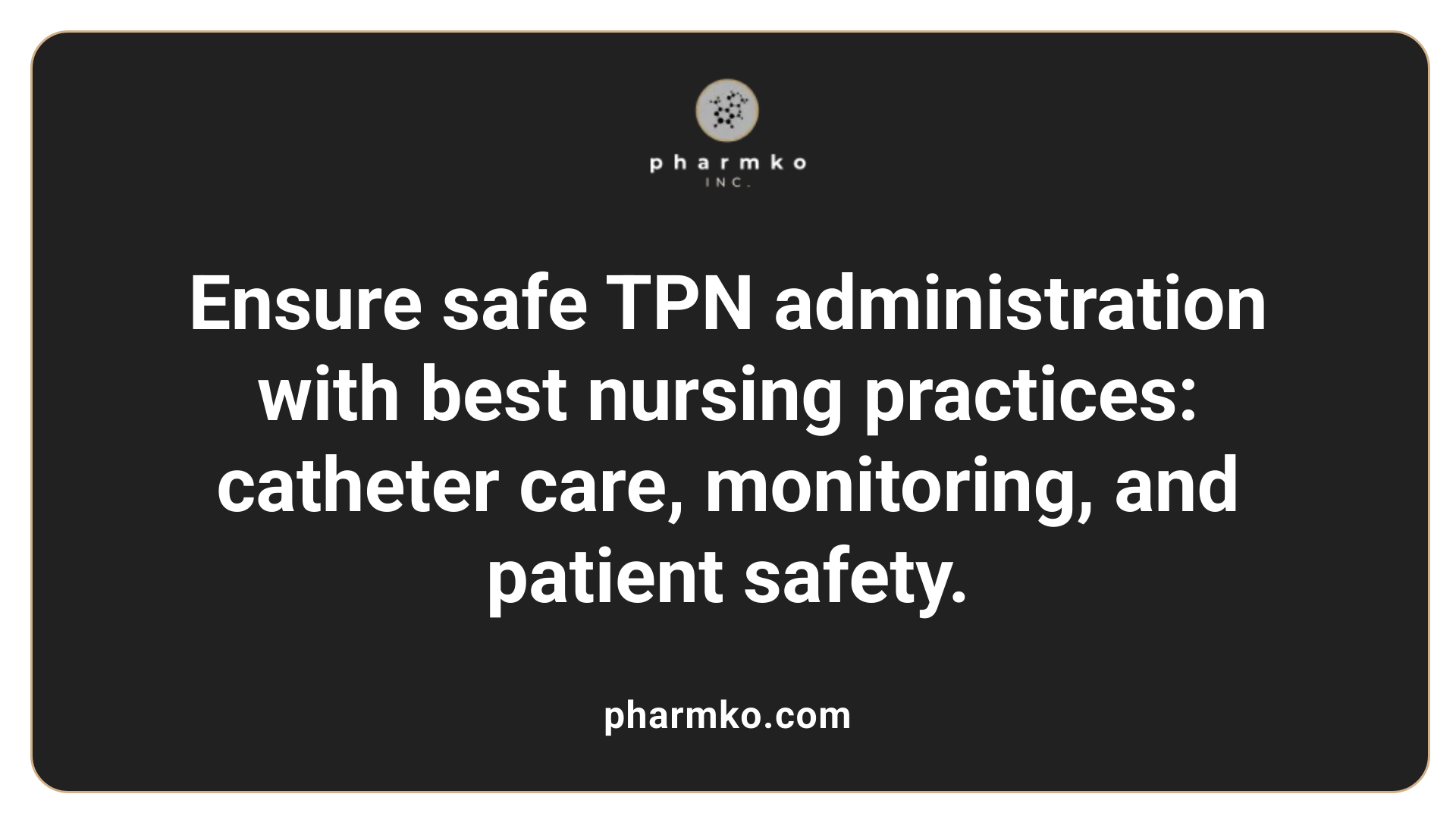
How is TPN administered and what are the guidelines for nursing practice?
Total Parenteral Nutrition (TPN) is typically administered through a central venous catheter, such as a PICC line, implanted port, or tunneled catheter, due to its high osmolarity. The catheter is inserted into a large vein that leads directly to the heart, ensuring safe and effective delivery of nutrients. Before starting TPN, thorough patient assessment and pre-administration preparation are essential. This includes checking laboratory results, blood sugar levels, electrolyte balance, and ensuring the catheter site is infection-free.
The TPN solution is custom-made for each patient, containing a mixture of lipids, dextrose, amino acids, vitamins, minerals, and electrolytes tailored to individual nutritional needs. During infusion, nurses must vigilantly monitor the patient for signs of complications. This involves tracking vital signs, blood glucose levels, and fluid balance, along with observing the catheter site for redness, swelling, or discharge.
Proper catheter care is vital to prevent infections. This includes strict aseptic technique during handling, regular site cleaning, and securement, along with routine assessment for signs of infection or thrombosis. Nurses should also manage the infusion equipment correctly, ensuring connections are secure and the pump functions properly.
Daily assessments should include monitoring intake and output, watching for symptoms such as fever, chills, or discomfort which could indicate infection. Routine blood tests are critical—checking electrolytes, blood glucose, liver function, and other parameters—to guide necessary adjustments in the TPN formulation.
Effective nursing practice involves patient education on catheter care, recognizing symptoms of complications, and maintaining hygiene to reduce infection risks. Timely intervention for issues like infections, metabolic disturbances, or vascular access problems is crucial to patient safety. Overall, adherence to clinical protocols, ongoing assessment, and clear communication with the healthcare team underpin safe and effective TPN therapy.
Evaluating Your Eligibility for TPN
Assessing whether you qualify for TPN involves a careful review of your medical history, laboratory results, and the functionality of your gastrointestinal system. Qualified patients typically demonstrate significant nutritional compromise due to functional or structural impairments of the GI tract that cannot be corrected or managed with enteral nutrition. A multidisciplinary healthcare team will determine your eligibility based on objective clinical criteria, documented gastrointestinal impairment, and previous attempts at nutritional support. If you meet these requirements, and your risks and benefits are appropriate, TPN can provide life-sustaining nutritional support, either temporarily or long-term. Regular monitoring and management are essential to ensure safety and optimize outcomes, making collaboration with specialized healthcare providers crucial in the evaluation process.
References
- Home parenteral nutrition - Mayo Clinic
- Home Total Parenteral Nutrition (Home TPN) - Nutrishare
- Total parenteral nutrition: MedlinePlus Medical Encyclopedia
- Total Parenteral Nutrition (TPN) | Aurora Health Care
- Understanding Total Parenteral Nutrition for Optimal Health
- Total Parenteral Nutrition (TPN) - Advocate Health Care
- A Guide to Home Parenteral Nutrition for New Patients
- [PDF] Total Parenteral Nutrition: Home Care Guide - Northwestern Medicine
- How Total Parenteral Nutrition (TPN) Works - Verywell Health
- [DOC] Administration of Total Parenteral Nutrition (TPN) – Adults













